 International InternationalLabour Office |
|
Workers' Activities |
|
|
Emerging Economies:
|
|
My point of departure is the striking disparity between labor costs across countries. Hourly labor costs for spinning and weaving operators ranged from $27.3 in Switzerland in early 1996, to half a dollar or even less in Indonesia, Sri Lanka, Bangladesh, Pakistan, Kenya and Madagascar. U.S. and U.K. costs are about $12 and German costs $22. These labor costs include not only wages but also social contributions which in some cases, Turkey, Belgium and Colombia, for example, are equal to the wage itself. The scale of wages alone is even wider, ranging from highs of $21 in Switzerland, $15 in Japan and $14 in Germany to about ˘ 30-35 in Pakistan, Madagascar, Kenya, Indonesia and China, a range of 70 to 1 mirroring the 80 to 1 spread of gross national product per capita.(3) How can labor and businesses in the industrial countries withstand competition from low-labor cost producers? A major reason is that many, perhaps most, of the exports are an integral part of industrial country corporations' strategies, so-called "production-sharing" between industrial and developing countries within vertically-integrated international manufacturing industries. For example, in the mid-1960s semi-conductors, valves, tuners and other components began to be assembled for international electronics firms in Hong Kong, Thailand, Malaysia and Singapore. Wearing apparel and leather goods were assembled in the Dominican Republic, Jamaica and the Philippines for transnational firms. And much of the trade generated by regional agreements such as NAFTA and special European Community tariff schedules consists of production sharing. There are no precise statistics about production-sharing, but in the early 1990s, at least $800 billion out of total world trade in manufactures of about $2.7 trillion (or 30 percent) consisted of some form of global production sharing operations, much of it among industrial countries but also a considerable amount between industrial and developing countries.(4) Production sharing is one of the main reasons why foreign direct investment has been pouring into East Asia as well as other low-wage areas.(5) |
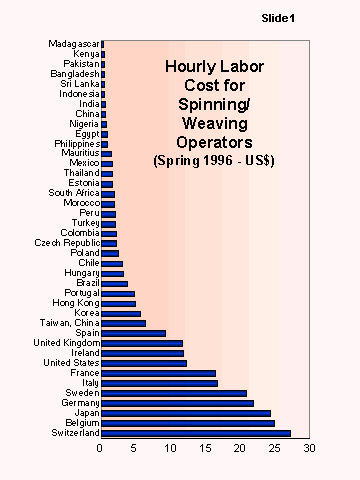 |
With this background, how long can the rise in emerging market exports last? One way to start is to ask why imports from emerging markets are not even larger. The major reason is that labor is not "cheap" where productivity is very low, and this is, unfortunately, the case in the vast majority of developing countries. Sub-Saharan Africa presents a striking example: even though wages are among the lowest in the world and even though the Lomé agreements allow African exporters virtually free access to the European market, only a single country, Mauritius, has expanded manufactured exports at a rapid rate. Likewise, it has been estimated that Mexican average productivity is about one-fifth that in the United States. Low productivity has to do with levels of training, but also with the broader setting in which manufacturing companies operate: the quantity and quality of the capital stock, in particular energy, transport and telecommunications, the quality and quantity of know-how. Relatively few developing countries offer productivity-enhancing environments. The point is made in a recent article in the Harvard Business Review: (6) "the low wages available in many countries, after adjusting for productivity, lose their attraction. When investing in developing countries, world-class manufacturers tend to locate their factories in the areas that have the most advanced infrastructure and workers' skills rather than in the areas that offer merely the lowest wages.
A recent survey of 223 expatriate managers based in Asia published in The Economist (7) documents perceptions of labor attributes in various Asian countries and compares them to those in industrial countries. The survey considers such factors as quality, cost, availability and turnover not only of unskilled workers but of all employees. On labor cost alone India comes out ahead, followed by the Philippines, Vietnam and China. But when labor quality, availability and turnover are also taken into account, India remains ahead but is followed, perhaps surprisingly, by Australia and the United Kingdom. Labor attributes in Vietnam and China are considered by these managers to be less attractive than those in the United States and even Switzerland where labor costs are highest.
| The gradual shift from low- to high-productivity activities, first from agriculture to light manufacturing, later to higher value-added industries and increasingly value-added services, is the essence of the development process (8) . During the last 20 years dollar manufacturing labor costs in Europe and Japan surged ahead of those in the U.S. In Korea and Singapore labor costs rose from 5-10 percent to over 40 percent of those in the U.S. On the other hand, in Mexico, labor costs fell from one-quarter those in the U.S. after the 1973 oil price increase to only 9 percent in 1995, reflecting periodic severe macroeconomic imbalances. | 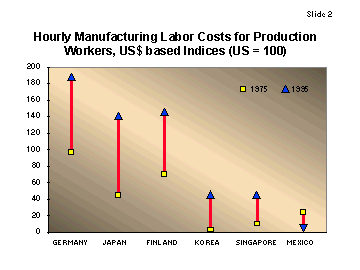 |
The upward movement of real wages may also reflect shifts at the corporate level from low value-added to higher-value added products. Also, following Kasra Ferdow's analytical framework, more and more firms will shift from seeking primarily access to low-cost production to seeking access to skills and knowledge as well as proximity to markets. Specialized off-shore factories established to produce specific items at low cost are only a first step in the development process.
So, if low wages don't necessarily mean low production costs, and if successful developing countries move out of labor-intensive product lines, why is there concern about globalization? Those who believe that globalization has become excessive tend to link massive imports of labor-intensive goods to high unemployment in Europe and low and stagnant wages for unskilled workers in the United States, and, more generally, to the drop in the share of manufacturing employment in industrial countries from 30 to 20 percent since 1970. More than 40 million workers in industrialized OECD countries are unemployed or roughly one in ten, and the gap between high-skill and low-skill wages has widened.
Other analysts take a different view, and argue that technical change which has been biased against unskilled labor-intensive production has been the main reason for the virtual disappearance of labor-intensive manufacturing in the industrial countries. While they agree that the process has been costly, especially in towns where textile and clothing, footwear and inexpensive electronic goods were important industries, they argue that the shift out of these industries was unavoidable. They also point out that out of a U.S. work force of 135 million, globalization and/or technical change caused less than one percent of employees to lose their jobs or, much more often, to shift into services activities at slightly (on average 10 to 15 percent) lower wages. (9)
Another line of argument against globalization is that capital flows from industrial countries to low-wage countries will hurt workers in industrial countries, as they will be working with lower capital stock, and hence be less productive. However, the cumulative effects of the emerging market investment boom since 1990 would have been to reduce the industrial capital stock of industrial countries by 0.5 percent, which in turn could have led only to a fall in real wages by one to two tenths of one percent in these countries.(10)
| Most analysts, even those who are
critical of globalization, agree that most of the limited unskilled job losses in
industrial countries have occurred already,(11)
and that in future the net benefits from globalization will increase: productivity will
rise and the real cost of goods in the industrial countries, especially goods purchased by
poorer families, will come down further. To most observers the benefits of globalization
to the developing countries themselves are not in doubt. Indeed, globalization has opened
up a faster track for those countries which are able to take advantage of trade
liberalization.
Still, until recently the world had not had to contemplate the prospect of massive increases of exports from China. Before concluding, I would like to take a look at China. Because of its large size this may serve to clarify some of the issues and help us to see what may lie ahead. How long will China's low-wage advantage last? This will depend largely on its relative endowment of labor, human capital and physical capital. As of now China is poorly endowed in land (0.12 hectares per worker) and in capital ($1,600 per worker, compared to $21,500 in Korea for example). Likewise, the average post-secondary education per worker is only two months. The following slides illustrate how long a way China has to go. The first slide shows the proportion of illiterate persons in a range of countries. |
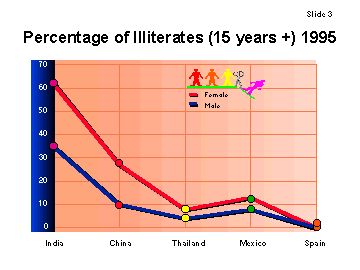 |
|
The next one shows the percentage of persons over age 25 who have a post-secondary education. The next two slides show how China compares in energy and telephones, two proxies for capital endowment.
|
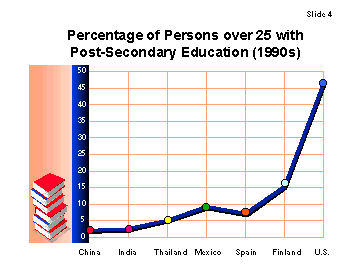 |
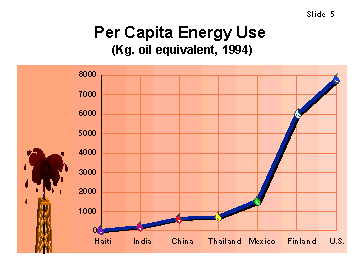 |
|
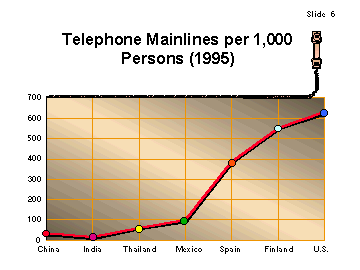 |
|
| On the labor supply side, the next slide shows how China (top line
in 1990) compares to other countries whose agricultural labor force has declined, as a
share of the total, over the past 30 years:
China, clearly has an enormous "reserve army of labor" which will be released gradually as agricultural productivity improves and jobs are created in the cities. All these slides suggest that China will, for a very long time to come, be a low-wage economy whose light industry can be expected to expand. Movements up the value-added ladder will occur, however. But accelerated capital formation may become more difficult as China's particular demographic situation unfolds. China's population is aging rapidly, a reflection of the one-child policy of the late 1970s and the 1980s and increased life expectancy. The crisis is dramatized by the "1-2-4" phenomenon (families of one child, two parents, and four grandparents): when the people who are currently entering the workforce retire (the four grandparents), they will have to be supported by one couple (the two parents). The ratio of workers to pensioners (age 65 and above) is projected to decline to about 3 to 1 in 2030 from the 10 to 1 in 1995. A more affluent and aging population will save less than today. (12) Savings should also decline as institutional and policy uncertainty diminishes. This will slow down the pace of capital formation and of modernization.
|
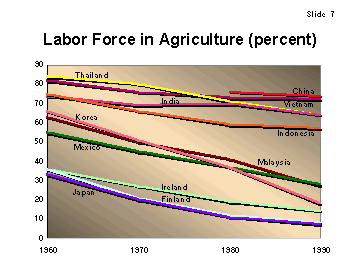 |
| To some extent, of course, China's
growing exports are displacing those of other developing countries whose labor costs have
been rising. Thailand is an interesting example of a country which, after many years of
very fast export growth, has been hit hard by rising labor costs. The challenge for Thai
manufacturers is to switch as soon as possible to higher value-added exports. This is not
an easy thing to do, particularly in a country which is experiencing an acute shortage of
skilled labor. Still, Thai firms are gradually changing their product mix. Between 1990
and 1995 the share of textiles, footwear and jewelry in total exports has declined from 25
to slightly under 20 percent; the share of electrical apparatus and appliances has
increased from 11 to 17 percent. Together, computers, parts, electrical apparatus and
appliances now account for one-quarter of Thailand's exports, the same proportion as
textiles, footwear and jewelry used to account for in 1990. In 1996, however, total
exports stagnated for the first time, showing how hard it is to substitute higher
value-added products for "cheap labor" ones.
It might be noted that Thailand today also provides an example of what can happen when rapid growth based on low labor costs is combined with heavy borrowing, speculation, and large wage increases. The deep currency crisis in Thailand now will require a period of adjustment. During that time, achieving financial balance will probably take precedence over further rapid expansion. The lesson is that labor cost advantages can be a powerful engine of growth, but current account deficits, a fragile banking system and international borrowing, especially short-term borrowing, can bring an economy to an abrupt slow-down. |
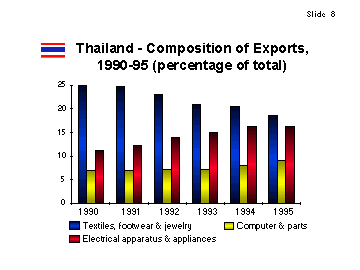 |
What about the cost-advantage of the highly-industrialized former socialist countries of Eastern Europe? These countries are endowed with large numbers of highly-trained persons, especially scientists and engineers. Very substantial amounts of foreign direct investment are flowing there, especially to Poland, the Czech Republic and Hungary, but also, increasingly, to the Baltic republics. Here as well, productivity is a key issue. Just because highly-qualified engineers are paid a few hundred dollars a month doesn't mean that production is internationally competitive; a less than first-rate institutional environment may well offset low-labor cost advantages. But as the institutional environment improves little by little, more businesses can be expected to locate in these transition countries. There is no reason to believe that scientific and engineering talent will become scarce to the point of raising real wages substantially in the coming years, nor is it likely that exchange rates will appreciate much. It will probably take 15 or 20 years before real wages in Poland, Hungary and the Czech Republic will be close to those of France or Germany.
In sum, while one may expect the low-labor cost advantage to continue for a long time, one should also bear in mind that businesses will continue to face difficult institutional environments which push up costs (for example weak financial systems, embryonic capital markets, untested judicial systems, high levels of crime in some countries, etc.)
The same is true of other developing countries capable of making more sophisticated products. Foreign automotive manufacturers now makes car engines in state-of-the-arts plants in Mexico. Indians have sufficient skills to produce software. Chinese can make sophisticated electronics in a Motorola plant, and Intel designs chips in Malaysia. However, the scarcity of skilled manpower is driving up wages (and widening wage disparities) in these countries. Indeed, if one includes skilled as well as unskilled employees, during 1995 and 1996 real wages have been rising especially rapidly in the Asia/Pacific region, and in China more than other countries, reflecting a tightening labor market for skilled workers and increasing wage disparities between skilled and unskilled labor, just like in the United States and elsewhere.(13) Add to that the fact that in most product lines the share of labor in total costs has come down substantially. Furthermore, if one takes into account productivity differences (which are due mostly to institutional and infrastructure deficiencies), real costs rise and the incentive to transfer production from industrial countries declines.
In any case, cost and productivity are only a part of the explanation for why production facilities are located as they are. For many products today differences in labor costs between countries, even where these differences may be quite large in percentage terms, are not a sufficient reason for moving production from high-wage countries. Why should this be so? One reason is that differences in cost attributable to wage and skill differences may not be very large in absolute terms. In fact, for many products the cost of transportation from one country to another can exceed the production cost difference. In addition, with today's production methods there is value attached to proximity both to suppliers and customers. Just-in-time methods, for example, place a premium on the ability to respond quickly to a manufacturer's demands and to achieve consistently high quality. It simply may be unfeasible to deal effectively with pipelines several weeks long, as would be the case with sea-based transport. Close proximity to customers can have similar advantages. (14)
With growing international mobility of capital and, even more important, international mobility of knowledge, the tendency of LDCs to catch up by catching on will accelerate. Whether is a problem for the industrial countries will depend largely on their macroeconomic, industrial and labor policies. The first thing to keep in mind is that newly-industrializing countries import as well as export. These imports, a large share of which will be purchased in industrial countries, will create jobs in these countries. Indeed, a recent OECD review (15) finds that OECD trade with China and the dynamic Asian economies, which together account for nearly half of OECD imports from developing countries, is close to being in balance. Second, a great deal of European unemployment is the result of labor regulations which have little or nothing to do with imports from low-wage countries. This, in part, explains the considerable difference in unemployment in continental Europe and the U.S. The more supportive industrial country policies are of structural adjustment, the more welcome will be the continued supply of imports from low-wage countries will be and vice-versa. (16)
Industrial countries can make it easier or harder on themselves to accept the inevitable. A reduction in indirect labor costs and a "flexibilization" of labor regulations would help greatly to move their labor force to higher productivity jobs and to provide their consumers with lower cost products. In contrast, protectionist actions or subsidies for unprofitable industries are not helpful, because they slow down structural adjustment in developing as well as industrial countries. Governments and consumer organizations can help by publicizing the benefits of globalization in releasing purchasing power and hence effective demand, which is employment-creating, by making many manufactured goods more affordable than they would be otherwise.(17) Last but not least, it is always easier to carry out reforms and to compensate losers in an expanding economy. Therefore in the end, how much of a problem continued growth in imports from developing countries will cause will depend very largely on whether the economies of Europe and Japan find their way back to more rapid growth.
Some politicians, notably Europeans, have been resisting structural adjustment on the grounds that that they reject "the American model", which they see as being inegalitarian, but when they compare degrees of income inequality they often consider only Europeans who hold a job; if one included the unemployed as well, the European picture would be much less attractive.
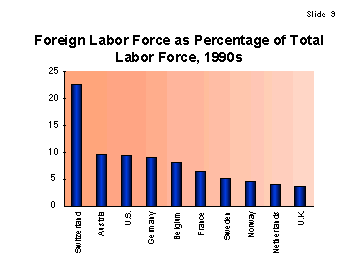 Another approach is to point out to
politicians that to some extent foreign investment and the free flow of goods are
substitutes for admitting larger numbers of temporary immigrants from low-wage countries.
Since the share of foreign workers in the labor force is considered by politicians to be
too high already in many industrial countries, (18)
a focus on international migration might help to convince politicians who dislike free
trade that the import of labor-intensive products might well be, in their eyes, the lesser
evil. The following slide shows the relative size of foreign labor. (19)
Another approach is to point out to
politicians that to some extent foreign investment and the free flow of goods are
substitutes for admitting larger numbers of temporary immigrants from low-wage countries.
Since the share of foreign workers in the labor force is considered by politicians to be
too high already in many industrial countries, (18)
a focus on international migration might help to convince politicians who dislike free
trade that the import of labor-intensive products might well be, in their eyes, the lesser
evil. The following slide shows the relative size of foreign labor. (19)
In conclusion, the answer to the question: How long will the low-wage advantage last? Is: a very long time, but I believe that the benefits of continued free trade and relatively free capital movements to the developing countries as well as to industrial country consumers and most producers outweigh the localized social costs which industrial country governments have to cope with. The vision that industrial countries are increasingly going to be flooded not only with labor intensive goods but, because knowledge is globally transferable, with knowledge-based goods as well fails to convey a full picture. Yes indeed, ships loaded with cheap goods, even knowledge-intensive goods, will cross the ocean from China, but they will not return empty. Regarding tradable manufactured goods, we are talking about a relatively small and declining portion of the industrial countries' economies. As for services, even with the much vaunted Indian software export development, wages for software designers are still rising in the United States, besides which most services cannot efficiently be traded internationally. In sum, Ross Perot has been proven wrong: there has been no "giant sucking sound", nor did the theme of "excessive globalization" figure at this year’s Davos meetings.
Annex: PPP
How do developing country families manage to survive at all with extremely low wages, e.g. US$30 a month in shoe factories in China? Besides the fact that in many countries employers provide mandatory non-wage benefits (notably in China), the main reason is that many prices are lower in poor countries than in rich. Such price differences are captured by calculations of purchasing power parity-painstaking statistical exercises comparing prices for similar goods and services across countries. The effect is very substantial. The 80 to 1 ratio between the most affluent five countries and the poorest five is 10 to 1 when price differences are taken into account. Furthermore, workers in developing countries tend to be younger and to have less formal education than those in industrial countries. A study of U.S. and Mexican manufacturing wages shows the following figures: the U.S. wage is about $11.60 an hour and the Mexican $1.30. If U.S. workers had the same education as Mexicans they would earn an estimated $3 fewer dollars, and if they were as young as average Mexican workers, their pay would be lower still by $1.70. The combination of differences in purchasing power, education and age amounts to about 80 percent of the Mexican-U.S. wage gap in 1990. In the author's words: "Mexicans are paid less than Americans but nowhere near the light years away that a simple reading of wage data suggests." (20) This helps to explain how families manage to live at what would be in industrial countries impossibly low wages.
| ||||